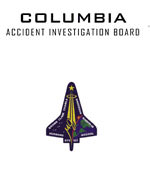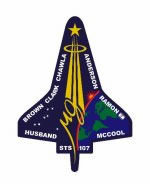With the Columbia accident investigation largely complete, workers at the Kennedy Space Center have begun packing up the 84,000 pieces of debris from the disaster. Unlike the debris from Challenger, which was packed away into two abandoned missile silos after the 1986 disaster, the material from Columbia will probably be made available for research. It may also show up in the Smithsonian Air and Space Museum in Washington, but NASA hasn’t decided if it’s appropriate or not. Officials expect to have the hanger clear of debris by the end of September.
Shuttles Will Return to Flight in March
NASA representatives met with the media on Monday and announced that the space shuttle would begin operations again some time between March 11 and April 6. Several safety changes are going to be made before the first shuttle, Atlantis, launches to visit the International Space Station: the bipod ramp (which shed foam on the Columbia launch) will be redesigned, and launch windows will only be in the day so cameras can track the launch. Perhaps the biggest changes, however, will come from NASA’s attempts to change its culture to improve safety. “We will be safety driven, not schedule driven.”
Columbia Accident Report Released

Image credit: CAIB
The Columbia Accident Investigation Board released its final report today, which was officially accepted by NASA Administrator Sean O’Keefe. The 250-page document contains an overview of the shuttle program in general, as well as STS-107. The report discusses the suspected cause of the Columbia accident – that foam falling from the fuel tank on liftoff smashed a hole in the shuttle’s left wing and allowed hot gas to enter during re-entry – but it also places a lot of emphasis on the weaknesses of NASA’s culture.
WASHINGTON, D.C. – The Columbia Accident Investigation Board today presented its final report on the causes of the Feb. 1, 2003 Space Shuttle accident to the White House, Congress and the National Aeronautics and Space Administration.
The CAIB report concludes that while NASA’s present Space Shuttle is not inherently unsafe, a number of mechanical fixes are required to make the Shuttle safer in the short term. The report also concludes that NASA’s management system is unsafe to manage the shuttle system beyond the short term and that the agency does not have a strong safety culture.
The Board determined that physical and organizational causes played an equal role in the Columbia accident – that the NASA organizational culture had as much to do with the accident as the foam that struck the Orbiter on ascent. The report also notes other significant factors and observations that may help prevent the next accident.
The Board crafted the report to serve as a framework for a national debate about the future of human space flight, but suggests that it is in the nation’s interest to replace the Shuttle as soon as possible as the primary means for transporting humans to and from Earth orbit.
The Board makes 29 recommendations in the 248-page final report, including 15 return-to-flight recommendations that should be implemented before the Shuttle Program returns to flight.
The report, which consists of 11 chapters grouped into three main sections, was the result of a seven-month-long investigation by the CAIB’s 13 board members, more than 120 investigators, 400 NASA and contractor employees, and more than 25,000 searchers who recovered Columbia’s debris.
Over the next several weeks, the Board expects to publish several additional volumes containing technical documents cited in the report or referenced as part of the investigation, as well as transcripts of the board’s public hearings.
The report can be viewed on our website at: www.caib.us
Please watch the NASA website for information about how to obtain hard copies or CDs of the Report.
Original Source: CAIB News Release
Columbia Report Will Be Released August 26

Image credit: NASA
The Columbia Accident Investigation Board will hold a press briefing on August 26 and discuss its final 250-page report on the cause of the space shuttle Columbia’s destruction on February 1, 2003. The report will be made available from the CAIB’s website at 1400 GMT (10:00 am EDT) and a live webcast will begin at 1500 GMT (11:00 am EDT). The 13-member board has already concluded that foam dislodged from the shuttle’s fuel tank struck the left wing on takeoff and create a crack that allowed hot gas to enter the wing on re-entry.
ARLINGTON, VA – The Columbia Accident Investigation Board will hold a press briefing to discuss its final report on the cause of the February 1, 2003 Space Shuttle accident on Tuesday, August 26, 2003 at 11 a.m. EDT at the National Transportation Safety Board boardroom at 429 L’Enfant Plaza in Washington, D.C.
Board Chairman retired Admiral Harold W. “Hal” Gehman Jr. and other board members will review the contents of the report and will answer questions from the press. The briefing is open to credentialed media only.
Only one printed copy of the report and a CD containing a .pdf file of the report will be provided to each credentialed news organization. Reporters and photographers who plan to attend the briefing are encouraged to send an email to notify CAIB Public Affairs at [email protected].
The report also will be posted to the CAIB website, www.caib.us, at 10 a.m. that morning. The 11 a.m. press briefing will be webcast from the same website.
The CAIB will provide a pooled, three-camera switched feed of the press briefing, with distribution on site. Still photography will not be pooled.
Questions about parking for satellite trucks should be directed to Terry Williams at the NTSB on Monday, August 25, 2003 at 202-314-6100.
Directions to NTSB Board Room: Front door located on Lower 10th Street, directly below L’Enfant Plaza. From Metro, exit L’Enfant Plaza station at 9th and D Streets escalator, walk through shopping mall, at CVS store take escalator down one level. Board Room will be to your left.
Original Source: CAIB News Release
NASA Needs Better Shuttle Pictures

Image credit: CAIB
The Columbia Accident Investigation Board released its fifth major finding today, which recommends that NASA improve the way it takes photographs of the shuttle launch. During the launch of Columbia, NASA cameras provided poor images from a critical point of view which would have showed foam falling from the external fuel tank more clearly. NASA is considering additional ground, aircraft, and even shuttle-mounted cameras to better document future launches. The final report is expected within a month.
The Columbia Accident Investigation Board today issued its fifth preliminary finding and recommendation to the National Aeronautics and Space Administration, in advance of its appearance in the final report.
Recommendation Five:
- Provide a capability to obtain and downlink high-resolution images of the External Tank (ET) after ET separation. Modifying one of the two umbilical cameras to meet this requirement is acceptable.
- Provide a capability to obtain and downlink high-resolution images of the underside of the orbiter leading edge system and forward section of both wings? Thermal Protection System (TPS).
Facts:
- Imaging the Space Shuttle System during launch and ascent provides necessary engineering data including the ability to examine the Space Shuttle System for any unexpected debris or other anomalies during ascent.
- The Shuttle has two on-board cameras that image the ET after separation, but the images from these cameras are available only post-flight.
- Very little engineering quality, on-board imaging of the ET was available for STS-107.
Findings:
- There is a requirement to obtain and downlink on-board engineering quality imaging from the vehicle during launch and ascent.
Background:
- The Space Shuttle is still a developmental vehicle, and engineering data from each launch is essential to further understand the vehicle.
- An ability to provide engineering quality imaging data of the ET after separation is important to determine if any debris from the ET was shed during ascent.
- Since the total elimination of all sources of debris has not yet been achieved, a much better understanding of all the potential sources of debris is required.
- Since the total elimination of all sources of debris has not yet been achieved, early detection of debris strikes against the forward underwing TPS of both wings will increase safety margins.
- The CAIB is aware of the excellent preliminary work already in progress at NASA in this area.
Original Source: CAIB News Release
NASA Considering What to Do with Shuttle Debris
As the Columbia accident investigation is wrapping up, NASA is considering what to do with the 84,000 pieces of debris; currently arranged on the floor of a hanger at the Kennedy Space Center. Several cities have requested pieces of debris for their memorials to the shuttle, and the agency is seeking guidance on how they can make it accessible while avoiding the “ghoulish factor” of putting it on display. Debris from the previous Challenger accident was packaged up and put into storage – that’s unlikely to happen with Columbia.
Shuttle Program’s Flaws Will Be Revealed
Investigators working to determine the cause of the space shuttle Columbia disaster are expecting to reveal some serious problems with NASA’s program that oversees shuttle safety. The investigation team interviewed 72 NASA employees and contractors over a period of months and learned there were serious gaps in the agency when it came to safety. Some inspections had been removed to cut costs; quality assurance staff weren’t allowed to perform “spot checks”; and the agency was using hopelessly outdated testing equipment.
Age Wasn’t a Cause of the Columbia Disaster
During a press briefing on Friday, investigators ruled out the age of the space shuttle Columbia as a contributing cause to its destruction. With the most recent foam test, which knocked a large hole in sample shuttle wing panel, the force of the impact would have broken through, even if the panel was brand new. Investigators believe the hole in Columbia was smaller than the one in the test panel; otherwise it would have broken up much earlier upon re-entry.
Hot Gases Breached a Shuttle Back in 2000
NASA has released photographs that show how the space shuttle Atlantis suffered damage from hot gases back in May 2000 when it returned through the atmosphere on a mission. The damage wasn’t permanent and repaired in time for its next mission four months later. NASA blamed the damage on improper installation of a seal between protective panels on the shuttle’s left wing. Atlantis is expected to be the first shuttle to return to space when NASA begins launches again in early 2004.
Test Blasts a Hole in Shuttle Wing
Columbia accident investigators fired a chunk of foam at a sample wing of the space shuttle on Monday, and managed to knock out a 40 centimetre hole. The investigators believe this is the “smoking gun” that proves how events led to the destruction of the space shuttle in February. The impact was so strong that it damaged some of the sensors designed to measure the damage. The board has already made preliminary recommendations about how NASA can improve its policies to reduce risks to the shuttle in the future, but their full report is due later this month.
